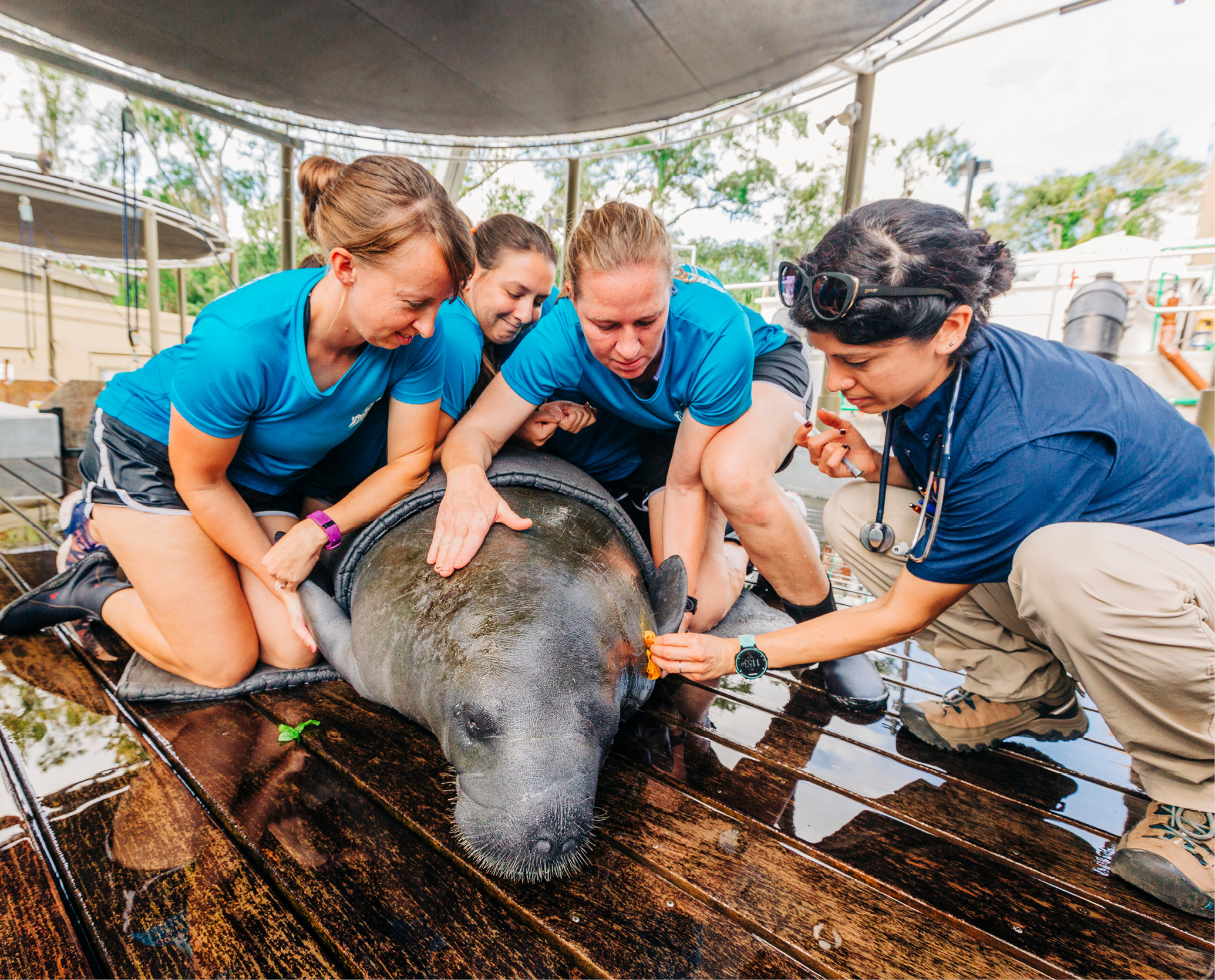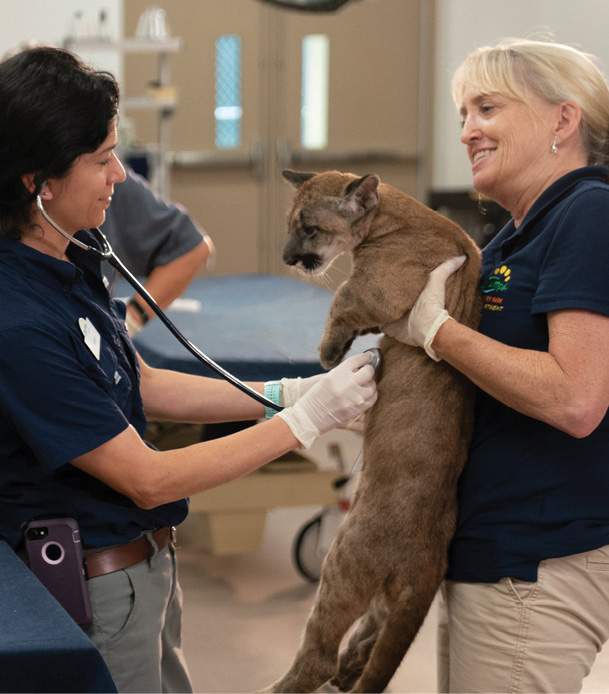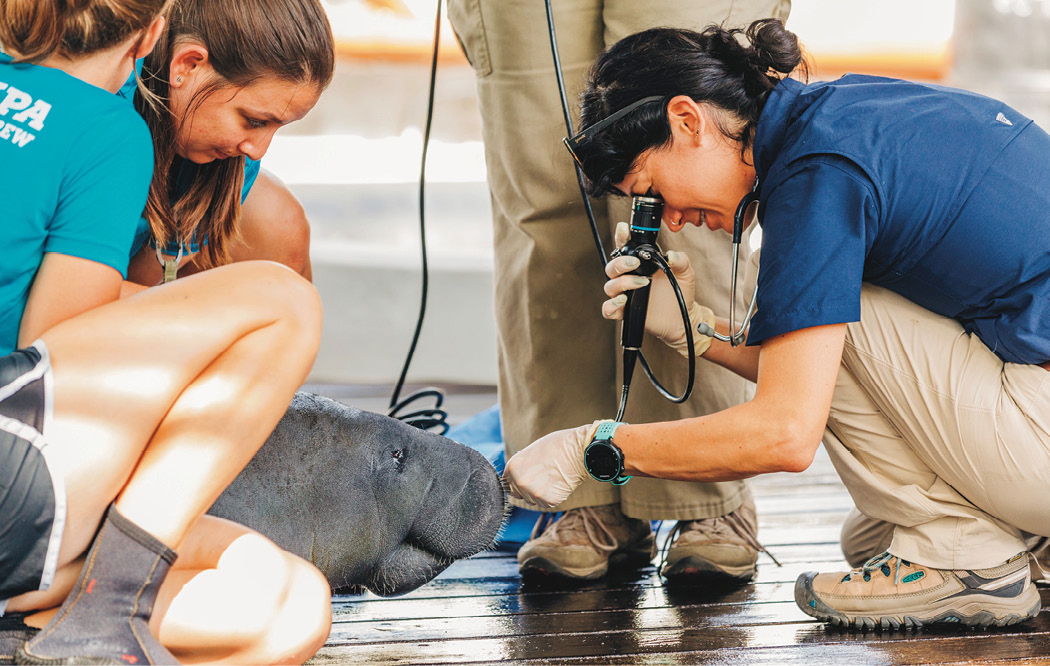AAHA Goes to the Zoo: Florida Is Home to the Only Accredited Zoo

by Tony McReynolds
AAHA HAS A ZOO! HOW COOL IS THAT?
ZooTampa at Lowry Park in Tampa, Florida, was named the “Number-One Family Friendly Zoo” in the United States by Parents magazine in 2009. This winter, ZooTampa was featured on a six-episode arc of National Geographic Wild’s behind-the-scenes TV series, Secrets of the Zoo. The nonprofit ZooTampa is home to more than 1,300 animals on 65 acres and has approximately 1 million visitors each year.
It also has first-rate veterinary care. Which isn’t surprising, given that ZooTampa is AAHA accredited. In fact, it’s the first and only AAHA-accredited zoo hospital in the world.
Most of that first-rate veterinary care takes place on ZooTampa’s Jacarlene Foundation Animal Care Campus, a cutting-edge facility for veterinary care housed in four main buildings: the Catherine Lowry Straz Veterinary Hospital, the animal nutrition center, the Tiedemann-Cotton Animal Care Annex (a state-of-the-art quarantine facility that provides additional space needed to handle the most sensitive cases), and the Sandy and Tom Callahan Center for Wildlife Conservation, which offers guest education on the zoo’s leadership in Florida- and worldwide wildlife conservation.
The Center for Wildlife Conservation is a nod to ZooTampa’s mission as a leader in the field of wildlife conservation. The zoo is also home to the David A. Straz Jr. Manatee Critical Care Center.
ZooTampa’s wildlife conservation efforts also extend to endangered species native to Florida, such as panthers and bobcats.

“I come into work and I know all the species we’ve got
at the zoo but I never know what’s going to
happen in the course of the day.”
—RYAN O’SHEA, CVT
The Plight of the Panthers
In July 2019, Florida Fish and Wildlife Conservation Commission (FWC) trail cameras caught footage of a radio-collared, female panther in the wild who appeared to be struggling to walk.
She also appeared to be pregnant.
The panther was exhibiting signs of a crippling neurological condition observed in more than half a dozen panthers and at least one bobcat in southern Florida. The mysterious and as yet unidentified condition affects the animals’ ability to control their back legs.
Concerned about the health of both the mother-to-be and her pending brood, the FWC decided to monitor the situation.
After the panther took to her den and gave birth to two kittens, FWC officials stepped in. “They were very concerned, and rightly so, that the kittens wouldn’t survive,” said Cynthia Stringfield, DVM. “They made the really difficult call to go in and remove the kittens.”
The FWC reached out to ZooTampa to help care for them.
Stringfield is ZooTampa’s head veterinarian and senior vice president of animal health, conservation, and education. As head veterinarian, she was also in charge of the team taking care of the kittens.
Stringfield says that ZooTampa has a very strong relationship with both the FWC and the US Fish and Wildlife Service and does a lot of conservation work with both agencies. “One of our missions is to be actively involved and educate the public,” she said.
Taking in the kittens, named Cypress and Pepper, was a no-brainer. The zoo had taken in sick panthers before and was already home to three adult panthers who are unable to survive on their own in the wild as a result of injury or illness.
Stringfield says the mom would have a better chance of survival if she didn’t have the distraction of raising her newborns. “It would take the pressure off her and also ensure the kittens’ survival, because having all three animals die [as a result of] this situation would be the worst possible outcome.”
And the most likely.
So Stringfield and her staff took the kittens in, bottle-fed them, and raised them by hand. Two weeks old at the time, the kittens lived. Thrived. And, unfortunately, got used to their human caretakers.
“They like people, so they can’t ever go back out,” Stringfield said. “They don’t have the skills to survive in the wild.”
So ZooTampa’s three panthers temporarily became five. Stringfield says the kittens will live out their lives under human care, but not at the zoo: “They’ll have a great life and a much better life than they likely would have had. I’m sure they wouldn’t have survived.”
Unfortunately, the mother didn’t fare as well.
Stringfield says the FWC continued to monitor her closely after removing the kittens, but her condition worsened—eventually she grew so debilitated that she had to be brought in and euthanized.
“That was a really sad decision,” Stringfield said. But hopefully not a futile one—specialists performed a battery of tests on her in hopes of discovering a clue to her condition. “They’re looking for everything—infectious diseases, environmental causes. Results are pending, but at the moment it’s still a mystery.”
As for the kittens, Stringfield says the prognosis is excellent. “They were watched very closely and evaluated very thoroughly,” she said. “We haven’t found anything and they seem to be fine.”
 Ministering to Manatees
Ministering to Manatees
ZooTampa’s David A. Straz Jr. Manatee Critical Care Center is the only nonprofit, acute-care facility in the world dedicated to manatee rehabilitation, and one of just three such rehab facilities contracted and federally permitted in the state of Florida. The center includes two exhibit pools totaling 200,000 gallons for underwater viewing; three 16,500-gallon treatment pools with remote-controlled floors; life support systems; an amphitheater for daily educational talks; and a public viewing platform on the boardwalk.
Last year, the center’s water filtration/life-support system underwent a $3 million upgrade. Lauren Smith, DVM, ZooTampa’s lead manatee veterinarian, calls it “the bones of the entire operation.”
“When you have these types of animals, you have to make sure your water is pristine,” Smith said. She’s been working with manatees for six years, and doing it at ZooTampa for four. As someone who’s always been fascinated by aquatic life, she says the job is something of a dream come true for her; originally, she wanted to be a marine biologist.
As a zoo veterinarian, Smith leads a dedicated team of animal care and veterinary staff that tend to the manatees 24 hours a day, seven days a week. Since 1991, the manatee hospital has treated more than 400 manatees and reintroduced 230 back into Florida waters.
The gentle, slow-moving herbivores, also known as sea cows, hold a special place in the hearts of Floridians and were named the official state mammal in 1975. Sadly, humans are responsible for approximately half of manatee fatalities. And Smith says it can get pretty brutal.
“We are a critical care hospital, so the animals come in severely debilitated,” she said. “They come in with a lot of trauma. We see a lot of watercraft injuries. They get hit by a boat, whether it be a propeller or a skeg.”
It’s not necessarily carelessness or maliciousness on the part of boaters. “Sometimes people don’t see manatees in the water and don’t even know they’ve hit them.”
Other threats to manatees include fishing gear entanglement, human harassment, habitat loss and degradation, red tide and other algal blooms, and climate change. The greatest long-term threat is the loss of a warm-water habitat.
The US Fish and Wildlife Service is mandated with protecting Florida manatees—who are covered by both the Marine Mammal Protection Act (1972) and the Endangered Species Act (1973)—and relies heavily on ZooTampa for help.
ZooTampa is currently home to 15 manatee patients brought in for rehabilitation and care following boat strikes, cold stress, and red tide injuries.
Smith says the center has taken in a total of 29 injured or otherwise distressed manatees since it reopened last March. Considerably fewer have been released.
In April, Roomba, a male manatee who’d been struck by a boat in 2018 and suffered a collapsed lung, became the first patient to be returned to the wild since the renovation. Other success stories followed.
Last December, after more than a year of rehabilitation and care, three more of ZooTampa’s manatee patients were released back into Florida waters. The trio, named Sriracha, Obsidian, and Slate, are now healthy calves weighing a combined total of more than 1,800 pounds.
Sriracha was rescued by the FWC on September 2018 along with his mom, Heinz, who’d suffered a boat strike injury. Sriracha was otherwise completely healthy and doing well. Obsidian and Slate were orphaned calves who were rescued together by the FWC in February 2018 after suffering cold weather stress. Smith’s team had been monitoring their growth to ensure they reached the appropriate weight to be released.
“We give them fluids, nutritional support through what we call a nasal gastric tube. And we also administer medications that way as well. It’s really important to keep them hydrated, try and start them on nutrition,” said Smith. Calves are also dewormed and given medications for any bacterial infections that could arise.
Young manatees who haven’t learned how to get through a Florida winter (something they normally learn from their mom) are considered “naïve,” meaning they didn’t have a mom to show them where to migrate in winter months. In those cases, the manatees are tagged with tracking devices upon release so FWC biologists can monitor their progress in the wild.
In the warm summer months, manatees travel freely around the rivers and coastal waters of the southeastern United States, and sightings in Alabama, Georgia, and farther north are common. When temperatures drop, they tend to congregate in warmer Florida waters.
In Sriracha’s case, says Smith, he’d had some winter experience with his mom. “But he came into a rehab situation at a very young age, at a time when he would be going through his first winter. He’s still considered naïve.”

ZooTampa is currently home to 15 manatee patients
brought in for rehabilitation and care following
boat strikes, cold stress, and red tide injuries.
Calves can remain at ZooTampa for up to a year and a half while they get up to a normal, healthy weight.
In preparation for their release, Smith’s team provided the manatees with a natural diet and worked on their socialization to ensure a smooth transition to the wild. Releasing manatees in the winter helps set them up for better success, as they can follow older manatees and learn how to migrate.
“It felt like we were getting in a manatee every other day” after Roomba’s release, Smith said. “Every year, the numbers go up and up and up in terms of mortalities.” She doesn’t know the actual cause of the increase but suspects that increased public awareness is part of it—as more people become aware of the manatees’ plight, they are reporting manatees they see in distress. Smith says that starts the ball rolling with the FWC, “and we can get out there and respond quickly.”
Meanwhile, Sriracha’s mother, Heinz, is still under ZooTampa care.
As manatee patients such as Heinz recover, visitors can see this life-saving care in real time in the recovery pools of ZooTampa’s Manatee Mangrove.
Working at a Zoo Versus Working in Small-Animal Practice
Ryan O’Shea, CVT, has been working at zoos since 2007, and he’s been at ZooTampa since 2015. He says the best thing about working at a zoo is the variety. “I come into work and I know all the species we’ve got at the zoo but I never know what’s going to happen in the course of the day.” He says you can plan your day out the same way you would at a small-animal practice, but at a zoo, “there’s always going to be something that pops in there.”
O’Shea speaks from experience; he started out in a small-animal practice, but as someone who always kept reptiles as pets, he longed for a different kind of veterinary action. “I enjoyed working with dogs and cats but I always had a fondness for odd animals. I would always take advantage of jumping into a reptile room or a bird room over anything else.”
Zoos were his calling.
“Everybody has their favorite [animals], and we’re all pretty aware of it,” O’Shea said. “So we do our best to get the person who’s most interested in that particular animal or animals working on cases involving those animals.”
Smith, the lead manatee veterinarian, has worked in both zoos and small-animal practice as well, and says the biggest difference between caring for companion animals and caring for zoo animals is the frequency with which she sees them. “Zoo animals are my patients, and the zookeepers are essentially my clients, so I get to see these animals every day.”
She also loves the diversity. “I’ve worked with all kinds of species. In one day, I can be working on an elephant or a manatee, then turn around and go work on a seahorse. We take care of [everyone].”
Like Smith, Stringfield has worked in small-animal practice, albeit in ones that also took care of exotic pets: “Certainly that adds a lot of additional species to the ones you usually see, but at the zoo it’s just a huge knowledge base because of all the different species we’re taking care of.”
She also mentioned the challenges of working with wild animals.
“We have to be really careful even if we’re anesthetizing them,” Stringfield said. “They can appear to be more asleep than they are. It’s easy to get hurt if you’re not really careful.”
Working with wild animals when they’re wide awake can be somewhat trickier, although animals considered dangerous are trained through positive reinforcement to work with the veterinary team. As an additional safeguard, the team can work with the animals through protected contact, like mesh.
Stringfield says she’s certainly taken her lumps. “Like most veterinarians, I’ve been kicked, bitten, scratched,” she acknowledged. “But I’m very, very careful and I have not been seriously injured.”
For example, Stringfield says she’s never been swiped by an elephant’s trunk, “and I hope never to be,” she laughed. Panthers are a different story. In fact, she was attacked last fall by one of the two panther kittens she was caring for.
Offhand, she can’t remember which one. Whomever it was, Cypress or Pepper, had just been anesthetized. “He looked like he was more asleep than he was. So I went ahead and lifted him up to the table . . .”
Stringfield paused. “And these are cats that like me,” she added. “They’re very friendly and attached to me.”
Nevertheless, while being anesthetized, Stringfield says the kitten went through an “excitatory phase.” The upshot? “I have a big a scar on my arm, from him trying to kill me.”
Stringfield doesn’t hold it against him; she pointed out that this was a wild animal attempting to protect himself. “We have to expect that. That’s what they do.”
The biggest surprise, perhaps, is that Stringfield finds working with zoo animals similar to working in a small-animal practice. It is, after all, just a matter of degree.
“Anybody who’s worked on domestic cats knows that when a feral domestic cat comes in, that’s exactly what we’re dealing with,” Stringfield said. “We’re working with a much bigger version of that.”
 |
Tony McReynolds is AAHA’s content editor and writer of AAHA’s NEWStat blog. |
Photo credits: All photos courtesy of ZooTampa at Lowry Park



